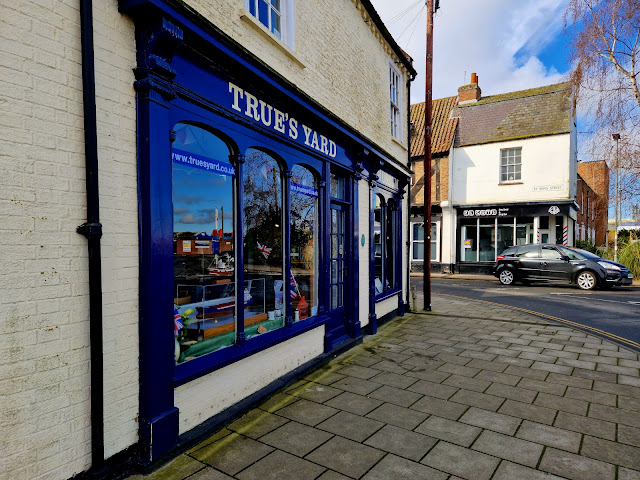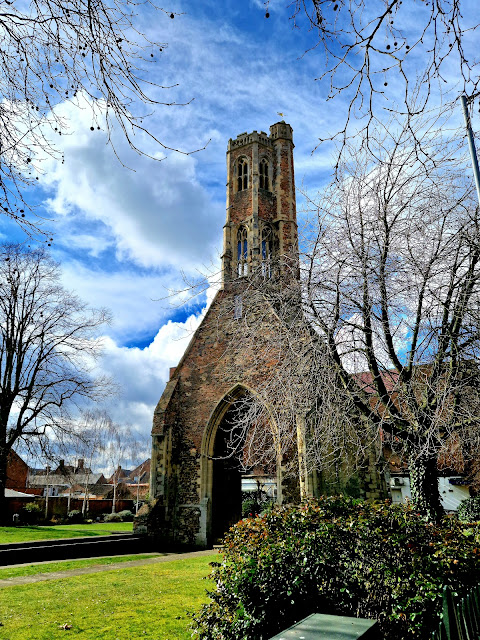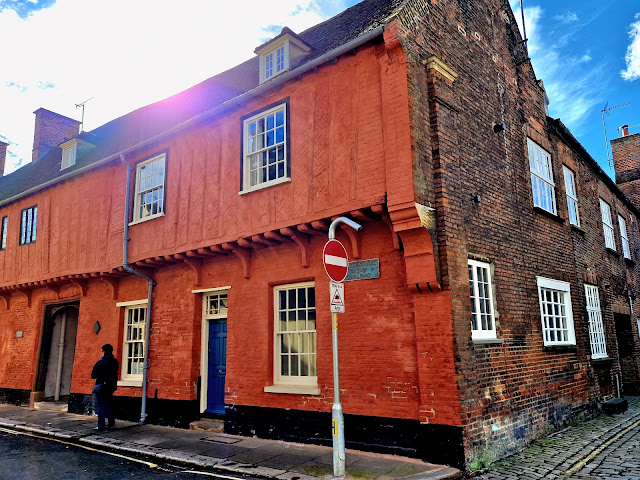On Tuesday the 8th March 2023 Mel and I drove from our hotel in Hunstanton to Kings Lynn and parked up in Boals Car park for just £2.90 for the day.
We leave the car park up Boal Street to a roundabout turning left onto Nelson Street that guides us to South Quay which is the start of the walk alongside the Great Ouse River.
We walk by Green Quay on our right. The Green Quay is housed in a warehouse with a 14th century ground floor and 15th and 16th century upper floors. Originally known as Marriott’s Warehouse, the building is now a discovery centre for The Wash. Here you can find out about the unique biodiversity of The Wash, discover how The Wash was formed and appreciate the future pressures on one of East Anglia’s most spectacular environments.
During the heyday of King's Lynn prosperity, this warehouse was the lifeblood of the town and was used to store corn loaded off visiting ships.
The name Lynn may signify a body of water near the town – the Welsh word llyn means a lake; but the name is plausibly of Anglo-Saxon origin, from lean meaning a tenure in fee or farm. As the 1085 Domesday Book mentions saltings at Lena (Lynn), an area of partitioned pools may have existed there at the time. Other places with Lynn in the name include Dublin, Ireland. An Dubh Linn....the Black Pool. The presence of salt, which was relatively rare and expensive in the early medieval period, may have added to the interest of Herbert de Losinga and other prominent Normans in the modest parish.
The town was named Len Episcopi (Bishop's Lynn) while under the temporal and spiritual jurisdiction of the Bishop of Norwich, but in the reign of Henry VIII it was surrendered to the crown and took the name Lenne Regis or King's Lynn. Domesday records it as Lun and Lenn, and ascribes it to the Bishop of Elmham and the Archbishop of Canterbury.
The town is generally known locally as Lynn.
 |
| View down an Alleyway to Kings Lynn Minster. |
During the 14th century King’s Lynn was ranked amongst the most important ports in England, and to this day houses the only 2 remaining hanseatic league buildings in England.
 |
| View down a road to the Town Hall. |
We walk on along the riverside to a bridge that crosses over a sluice into Kings Staithe Square.
One of the most recognisable buildings in King’s Lynn is the Custom House built by Henry Bell in 1683 as a merchants’ exchange. The building was used as a customs house from the 18th century until 1989. It was the first classical building to be built in King’s Lynn, and it is now open to the public as a museum.
We pass the statue of George Vancouver.
Captain George Vancouver RN born in King's Lynn (June 22, 1757 – May 10, 1798) was an officer in the British Royal Navy, best known for his Vancouver Expedition maritime exploration of the North America's north-western Pacific Coast regions, including the coasts of contemporary Alaska, British Columbia, Washington and Oregon. He also explored the Hawaiian Islands and the southwest coast of Australia.
We pass the Custom House and turn
left on to King Street.
We reach St Georges Guildhall on King Street. The Guildhall of St George is currently in the ownership of the National Trust. At present it is leased on a long lease by the Borough Council of King's Lynn and West Norfolk for hire by the public as a space for music, performances, lectures and entertainments.
It was built for the Guild of St George, which was founded in 1376.
The historic Guildhall of St George is the largest surviving medieval guildhall in the country. The Guildhall was created for the Guild of St George at the beginning of the 15th century.
An impressive square which still holds a market every Tuesday and hosts town events including Festival Too in the summer, which is Europe’s largest free festival. In the cold months of February, the market place also hosts the Mart which is a funfair for the whole family to enjoy.
The north side of the square, specifically the buildings numbered 15 and 16, house a permanent reminder of another purpose of the square. The Tuesday Market place, in the past, was a site of public executions.
Even before the witchfinder general Matthew Hopkins began his purges of witches in the East of England, people were accused of witchcraft. There is a legend that a lady named Margaret Reed in 1590 was accused and found guilty of witchcraft in King’s Lynn. Her punishment for this crime? Burning at the stake in King’s Lynn’s Tuesday market place. The story goes that as she was being consumed by the flames, her heart burst from her body and struck the wall on those buildings numbered 15 and 16 on the square. The still beating heart then fell to the ground and rolled into the River Ouse where the water bubbled and frothed until the heart finally sunk to the bottom. The building where the heart struck was scarred, carved into the red brick is a diamond shape and within that is a heart shape, the heart of Margaret Reed.
Today the market was a mere 6 stalls !
We continue straight on past the Corn Exchange and then bear right around the Market Place and into St Nicholas Street.
 |
| Wool Market House |
The handsome Grade II listed building is a former merchant's house which was built in the mid-15th century. It was recently converted into a four-bedroom home and is now on the market with Brown & Co at a guide price of £550,000 back in 2020.
It was once home to the famous artist and political activist, Gustav Metzger, who used it as his studio. He was born in Nuremburg in 1926 and came to Britain in 1939 as a refugee. He attended the Royal Academy of Fine Arts in Antwerp between 1948 and 1949 and later lived in London.
At the end of St Nicholas Street is St Nicholas Chapel.
England’s largest surviving parochial chapel, St Nicholas’ Chapel or the Fishermen’s Chapel was founded in 1146 as a chapel of ease to St Margaret’s Church. The roof of this Grade I listed building features a series of beautifully carved angels.
We turn left onto
St Ann’s Street and at the end we turn right on to North Street.
We pass Trues Yard. True’s Yard is virtually all that remains of King’s Lynn’s old fishing community, the North End.
Once hundreds of families lived within a stone’s throw of the beautiful mediaeval chapel of St. Nicholas. The North End had its own boat builders, chandlers, sailmakers, pubs, bakehouses and school.
The hard and sometimes dangerous life they led bred a fierce loyalty in the Northenders – they supported each other in times of crisis, seldom married anyone from outside the North End and cared for their widows and orphans. The menfolk would sail up to 100 miles away to bring in their catch and their women would tend the children, wait, pray and mend the nets when they came home.
The fishing fleet still sails from King’s Lynn, but the old way of life has gone.
There is now a museum here on the bygone fishing life.
At the end we turn right on to John Kennedy Road. We continue down this road (which
becomes Railway Road) until we reach the cross road junction with
Blackfriars Street and Blackfriars Road.
This is a busy loud road, not the most pleasant of walking.
We cross to the corner of Blackfriars road and follow the path in to The Walks.
We walk down to the fountain and then turn left on to a path that
heads back up towards the road.
This path takes us past St John’s Church and on to St John’s Walk.
When John Motteux, owner of Sandringham, attended a service at St Nicholas’ Chapel in 1843, he was forbidden to sit in any pew because (in those days) these had to be paid for. He therefore offered £1,000 towards building a new church where seats would be free. The building was completed in 1846, paid for by subscriptions, and designed by the architect Anthony Salvin in the Early English style and faced with Yorkshire sandstone. The St John’s congregation are very proud of this heritage and still seek to live out what it means to be ‘the poor man’s church’ today.
After passing the church, bear right off St John’s Walk and follow the path to the Red Mount Chapel.
Red Mount Chapel is an unusual
15th century wayside chapel
that was part of the Walsingham
pilgrimage route. The chapel
was also used by soldiers during
the Civil War, who left interesting
graffiti in the interior.
Sadly locked up so we couldn't have a look inside.
We walk on through St James Park and pass the old Town Wall ruins and along Broad Walk towards Millfleet.
The walk follows Millfleet back to South Quay and is 2 miles in length. But we aren't ready to finish seeing Kings Lynn yet and we turn off and walk up Tower Place.
We walk on up Tower Place and up to the modern shopping centre.
The tower, known as Greyfriars Tower survives. It is one of only three surviving Franciscan monastery towers in England and is considered to be the finest.
Following the Dissolution of the Monasteries by Henry VIII, the tower at Lynn remained because it was considered to be a useful seamark by sailors entering the town, still being clearly visible on the town's skyline to this day.
The tower is informally referred to as 'the leaning tower of Lynn' as it leans dramatically to the west. At its worst, the lean was 67.5 centimetres - which given its height of more than 28 metres is just over 1 degree. This compares to 3.98 degrees on the Leaning Tower of Pisa.
Although it is not believed to be in imminent danger of collapse, until recently it did require work to correct the lean to ensure it remains a part of the King's Lynn skyline.
Walking on we reach Kings Lynn Minster, but first we cross the road to look at the Town Hall.
Trinity Guildhall/Town Hall - The guildhall dates to the early 15th century. The building is of brick, but has a magnificent façade of chequered flushwork, with a 17th century porch. Next to the guildhall is the Town Hall, built in 1895 in the Elizabethan and Gothic Revival styles. It also has chequered flushwork to complement the façade of the guildhall. The complex includes a late 18th century courthouse and cell block, as well as a cell block dating from 1937, with many original fittings.
The building dates from the 12th to 15th centuries, with major restoration of the nave in the 18th century. Five of its ten bells and its organ also date back to the mid-18th century.
Benedictine priory
The church was established by Herbert de Losinga, Bishop of Norwich in 1095 to serve a Benedictine Priory and dedicated to St Margaret of Antioch. The priory was subordinate to the Priory of the Holy Trinity in Norwich.
The slender 12th-century south-west tower in the Early English Gothic style precedes the larger north-west tower in the Perpendicular style of the 15th century. The chancel with clerestory dates from the 13th century, when the earlier Norman nave was replaced. Elements of the Norman building survive in the base of the south-west tower.
After the English Reformation St Margaret's became the parish church for the town of King's Lynn, and its property was used as an endowment for Norwich Cathedral. Prior Drake was made prebend of the fourth stall in Norwich Cathedral.
The central lantern and south-west spire collapsed in 1741, which destroyed much of the nave. This was reconstructed in a programme of rebuilding between 1745 and 1746 by the architect Matthew Brettingham in an early Gothic revival style. The church retains its medieval misericords.
St Margaret's church was granted the honorary title King's Lynn Minster in 2011 by the Bishop of Norwich.
We leave the church and cross over and walk down St Margaret's Lane and back down to the river.

































